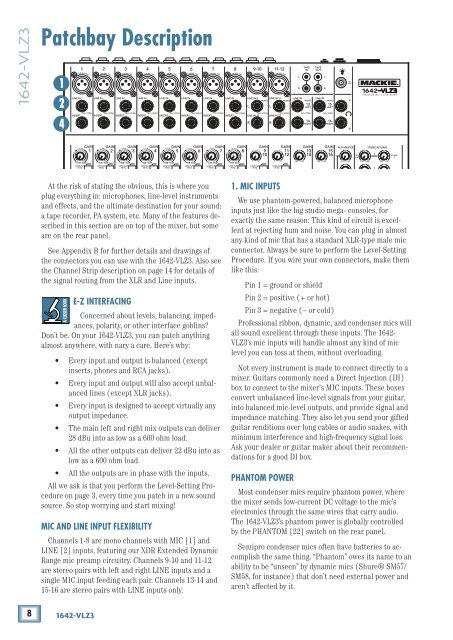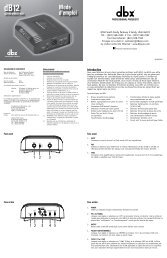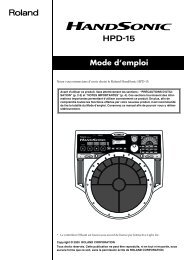1642-VLZ3 16-Channel Mic/Line Mixer Owner's Manual
1642-VLZ3 16-Channel Mic/Line Mixer Owner's Manual
1642-VLZ3 16-Channel Mic/Line Mixer Owner's Manual
You also want an ePaper? Increase the reach of your titles
YUMPU automatically turns print PDFs into web optimized ePapers that Google loves.
<strong><strong>16</strong>42</strong>-<strong>VLZ3</strong><br />
Patchbay Description<br />
1<br />
2<br />
4<br />
At the risk of stating the obvious, this is where you<br />
plug everything in: microphones, line-level instruments<br />
and effects, and the ultimate destination for your sound:<br />
a tape recorder, PA system, etc. Many of the features described<br />
in this section are on top of the mixer, but some<br />
are on the rear panel.<br />
See Appendix B for further details and drawings of<br />
the connectors you can use with the <strong><strong>16</strong>42</strong>-<strong>VLZ3</strong>. Also see<br />
the <strong>Channel</strong> Strip description on page 14 for details of<br />
the signal routing from the XLR and <strong>Line</strong> inputs.<br />
E-Z INTERFACING<br />
Concerned about levels, balancing, impedances,<br />
polarity, or other interface goblins<br />
Don’t be. On your <strong><strong>16</strong>42</strong>-<strong>VLZ3</strong>, you can patch anything<br />
almost anywhere, with nary a care. Here’s why:<br />
• Every input and output is balanced (except<br />
inserts, phones and RCA jacks).<br />
• Every input and output will also accept unbalanced<br />
lines (except XLR jacks).<br />
• Every input is designed to accept virtually any<br />
output impedance.<br />
• The main left and right mix outputs can deliver<br />
28 dBu into as low as a 600 ohm load.<br />
• All the other outputs can deliver 22 dBu into as<br />
low as a 600 ohm load.<br />
• All the outputs are in phase with the inputs.<br />
All we ask is that you perform the Level- Setting Procedure<br />
on page 3, every time you patch in a new sound<br />
source. So stop worrying and start mixing!<br />
MIC AND LINE INPUT FLEXIBILITY<br />
<strong>Channel</strong>s 1-8 are mono channels with MIC [1] and<br />
LINE [2] inputs, featuring our XDR Extended Dynamic<br />
Range mic preamp circuitry. <strong>Channel</strong>s 9-10 and 11-12<br />
are stereo pairs with left and right LINE inputs and a<br />
single MIC input feeding each pair. <strong>Channel</strong>s 13-14 and<br />
15-<strong>16</strong> are stereo pairs with LINE inputs only.<br />
1. MIC INPUTS<br />
We use phantom-powered, balanced microphone<br />
inputs just like the big studio mega- consoles, for<br />
exactly the same reason: This kind of circuit is excellent<br />
at rejecting hum and noise. You can plug in almost<br />
any kind of mic that has a standard XLR-type male mic<br />
connector. Always be sure to perform the Level-Setting<br />
Procedure. If you wire your own connectors, make them<br />
like this:<br />
Pin 1 = ground or shield<br />
Pin 2 = positive (+ or hot)<br />
Pin 3 = negative (– or cold)<br />
Professional ribbon, dynamic, and condenser mics will<br />
all sound excellent through these inputs. The <strong><strong>16</strong>42</strong>-<br />
<strong>VLZ3</strong>’s mic inputs will handle almost any kind of mic<br />
level you can toss at them, without overloading.<br />
Not every instrument is made to connect directly to a<br />
mixer. Guitars commonly need a Direct Injection (DI)<br />
box to connect to the mixer's MIC inputs. These boxes<br />
convert unbalanced line-level signals from your guitar,<br />
into balanced mic-level outputs, and provide signal and<br />
impedance matching. They also let you send your gifted<br />
guitar renditions over long cables or audio snakes, with<br />
minimum interference and high-frequency signal loss.<br />
Ask your dealer or guitar maker about their recommendations<br />
for a good DI box.<br />
PHANTOM POWER<br />
Most condenser mics require phantom power, where<br />
the mixer sends low-current DC voltage to the mic’s<br />
electronics through the same wires that carry audio.<br />
The <strong><strong>16</strong>42</strong>-<strong>VLZ3</strong>’s phantom power is globally controlled<br />
by the PHANTOM [22] switch on the rear panel.<br />
Semipro condenser mics often have batteries to accomplish<br />
the same thing. “Phantom” owes its name to an<br />
ability to be “unseen” by dynamic mics (Shure® SM57/<br />
SM58, for instance) that don’t need external power and<br />
aren’t affected by it.<br />
8 <strong><strong>16</strong>42</strong>-<strong>VLZ3</strong>
















